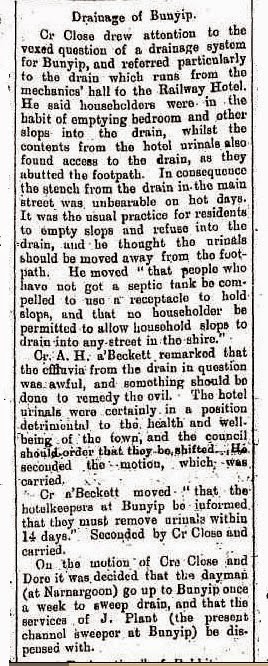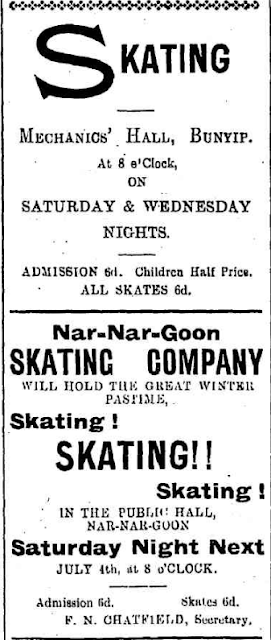1914 started off with an attempt to start a soccer league in the area. The Lang Lang Guardian reported on January 14, that Mr Frank Garwood of Modella wanted to start a British Association Football League. The League would cover the area between the two Railway lines - Koo-Wee-Rup to Lang Lang and Garfield to Longwarry. There was already at least one team practically formed at Modella. Mr Garwood urged anyone interested in playing the English soccer game (NOT rugby, as he emphasized) to contact him.
Lang Lang Guardian January 14, 1914
Read the full article here - http://nla.gov.au/nla.news-article119510085
The Weekly Times reported on February 21, 1914 on Mrs Agnes Hudson’s will. She left Real Estate worth £5595 and personal property of £1634. Mrs Hudson had died on December 10, 1913 aged 86. She owned The Grange, the oldest extant house in Koo Wee Rup. 1914 also saw the death of David Mickle (her son by her first marriage to Alexander Mickle), who was born in 1858. His death was reported in The Argus of November 25.
On March 1, the Lang Lang Guardian reported that the erection of the Lubecker Steam bucket dredge on the Lang Lang River was nearly complete. The dredge had been imported by Public Works Department Engineer, Carlo Catani, from Germany at a total cost of £4716. It spent a few years working on the Lang Lang River and when it finished there in 1916 it moved on to work on the Main Drain.
On April 8, the Lang Lang Guardian reported that 92 crates of rabbits, each containing 24 pairs was sent off from the Lang Lang railway station. That’s 4,416 rabbits! No wonder the paper reports that it was now an important industry!
Lang Lang Guardian April 8, 1914
On April 23, the Bunyip Free Press reported that a Caledonian Society had been formed in Koo Wee Rup. The inaugural meeting was attended by members of the Bunyip and Cranbourne Caledonian Societies. The purpose of the Society was to promote Scottish culture. Mr R. Laidlaw was elected Chief and the Chieftains were J.Hudson (the son of the aforementioned Agnes Hudson), H. Beattie, Mr Christie and Mr Bethune. A Highland Gathering was planned for December 28 with prizes for Highland dress, piping and dancing, tossing the caber, throwing the hammer and putting the stone (which I presume is the forerunner of the shot put) and tossing the sheaf.
On June 24 the Lang Lang Guardian reported that the old Yallock Mechanics Institute was being demolished. The replacement Hall was finished a few months later and officially opened on September 30. The Hall was 26 feet by 50ft, with a 9ft stage; there was a supper room which was 26ft by 10ft and two other rooms each 20ft by 12ft. These last two rooms were made from the timber of the old hall. The dance floor was built of Tasmanian oak. The cost of the hall was £300. The opening ceremony consisted of a concert, then supper at 11.40pm followed by dancing. The Hall (or part of it) was moved into Bayles in the early 1930s (Report of the opening of the Hall was in the Lang Lang Guardian, October 7 1914).
Also in the news - John Colvin was given the contract to enlarge and renovate the Koo Wee Rup Hall (South Bourke and Mornington Journal, September 3, 1914). In October, the Bill to authorise construction of the Koo Wee Rup to McDonalds Track Railway was passed - construction began in August 1915 (The Argus, September 22 1914). In November , the additions to St John’s Catholic Church were opened. (The Argus, November 2, 1914)
And finally my favourite report from 1914 was from the Lang Lang Guardian of October 28. Reverend Butchers, the Presbyterian Minister from Cranbourne, was driving to Koo Wee Rup to conduct the wedding of Mr A.C Colvin and Miss Johnston, unfortunately he was thrown from the vehicle and his collar bone was broken and his shoulder dislocated. Lucky for everyone, one of the wedding guests found Rev Butchers on the road, drove him home and then secured the services of the Church of England Minister and brought him out to perform the wedding. Weddings were much simpler in those days. Mr Colvin had started a cycle shop in the town in 1909
Lang Lang Guardian October 28, 1914


























